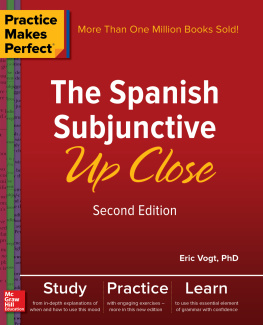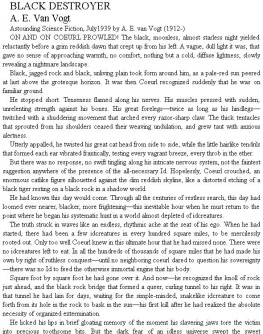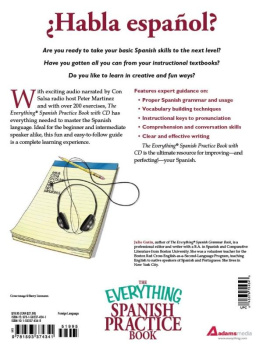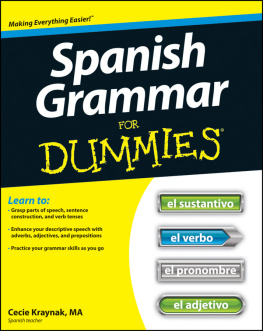Contents
Guide

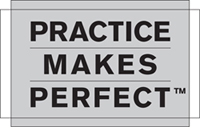
The Spanish
Subjunctive
Up Close
Copyright 2017 by McGraw-Hill Education. All rights reserved. Printed in the United States of America. Except as permitted under the United States Copyright Act of 1976, no part of this publication may be reproduced or distributed in any form or by any means, or stored in a database or retrieval system, without the prior written permission of the publisher.
1 2 3 4 5 6 7 8 9 LCR 22 21 20 19 18 17
ISBN 978-1-260-01074-9
MHID 1-260-01074-0
eISBN 978-1-260-01075-6
eMHID 1-260-01075-9
Interior design by Village Typographers, Inc.
Trademarks: McGraw-Hill Education, the McGraw-Hill Education logo, Practice Makes Perfect, and related trade dress are trademarks or registered trademarks of McGraw-Hill Education and/or its affiliates in the United States and other countries and may not be used without written permission. All other trademarks are the property of their respective owners. McGraw-Hill Education is not associated with any product or vendor mentioned in this book.
McGraw-Hill Education books are available at special quantity discounts to use as premiums and sale promotions, or for use in copyright training programs. To contact a representative, please visit the Contact Us pages at www.mhprofessional.com
Contents
Preface
Are you tired of a lot of song and dance about what the subjunctive is and how to use it correctly? Well, its time to get to know the subjunctive up close. Although many reference grammars and textbooks cover the topic, too many treat it hastily or in a haphazard fashion. Have your textbooks orGod forbid!your teachers confused you with list after list of verb phrases and conjunctions, trying to get you to understand what the subjunctive means to native speakers of Spanish? Do your eyelids droop even in the daytime, or your teeth clench at the sound of the word subjunctive? If so, this is the book for you.
As often happens when one is confused by a subject, you may need to unlearn before you can relearn. If this is your first exposure to the subject, then this book will save you from the abyss of confusion resulting from the numerous ill-conceived, incomplete, or diluted ways in which the subjunctive has often been treated.
Intermediate to advanced learners can profit from this book and begin to conquer the feared subjunctive in three or four weekends of systematic study. Practice Makes Perfect: The Spanish Subjunctive Up Close has been designed for people who have been or are being exposed to the subjunctive in any sort of language program. It is ideal as a stand-alone text for independent study or review or as a complementary text to any existing textbook, either for when the subjunctive is first introduced or in a grammar review or conversation class. The only tenses you need to know well to use this book to maximum advantage are the present indicative and the preterite.
Whoever the user of this book might be, one thing is certain: Ill tell it like it is about the Spanish subjunctive and tell you what you need to do to learn it and use it correctly. Here, youll find all the facts, nothing withheld or spread out over weeks of chapters but all presented boldly and progressively, with exercises and answer keys that do more than just give the right answers. Youll find many answers explained, in English, from the psychological perspective of a native speaker of Spanish. So take the time to follow my advice as you study. It will be as if I were standing next to you while you do your homework. I promise to demystify what has been too often overcomplicated or incorrectly presented in many books Ive seen in twenty-five years of teaching. I promise I wont mince my words. And if you promise yourself to study it carefully and thoughtfully, putting the concepts to work in your oral and written use of Spanish, your communication skills in this beautiful language will improve a great deal. Next thing you know, youll be fluent.
First of all, it is important to accept something many books dont openly declare: the subjunctive doesnt mean anything!
So, just what is the subjunctive, then? In a nutshell, it is a set of verb forms required in clauses of certain types. Trust me. Thats all it is, and that succinct definition is what I am going to unpack in this book. The subjunctive is hardwired into the architecture of the language, if youll forgive my mixed metaphors. In translation, the difference between a Spanish speaker using an indicative or a subjunctive form often disappears; that is, it conveys no meaning in and of itself, but that doesnt mean it isnt important. Its essential. Sure, honest attempts in all sorts of textbooks will offer English translations in which youll see the word may or might before an English verb to try to show what the subjunctive is doing in the original Spanish. Since may and might, as counterparts of the subjunctive, only work sometimes, they seldom are enough to emotionally or intellectually convince language learners, or earn their trust. After all, if the function of the subjunctive was solely to convey uncertainty, why not just say tal vez (perhaps) before an indicative and forget about the subjunctive? But then, if that were enough to explain the essence of the subjunctive, how would one explain that tal vez is an expression often, but not always, followed by the subjunctive?
Clearly, something must be done to clear all this up! By the way, if you dont know what the terms clause or indicative mean, you may need to look them up before you continue. A standard dictionaryor, better yet, an English grammar referencewill quickly bring you up to speed with all the terminology you need.
Being noticeably foreign can have negative or positive connotations. You may wonder why you cant just get by without the subjunctive, and the answer is, of course, that you could, but you would forever be a marginal participant in the Spanish-speaking world. A person who speaks or writes broken English will get by too, but he or she remains cut off from much of the richness of American cultural life. If you consider the impression youll make on native speakers of Spanish and dont care about the consequences of speaking subjunctivelessly, then dont buy this book, or, if you have already, I hope you kept your receipt.
A brief anecdote may be helpful to convince you of the need to take this subject seriously. I once knew a woman who had been inexplicably placed in a responsible position to negotiate with high-level administrators in Mexico. Prior to embarking on what would prove to be a cultural embarrassment to the organization she represented, because she had convinced the right people that she spoke Spanish, she confided to me in an ironically boastful tone that she spoke Spanish fluently but quickly added,... oh, except for that subjunctive in those compound tenses and if clauses. The exasperating thing was that she could identify her exact problem but had not taken the time to solve it. Since one use of the subjunctive is to express hypothetical situations, her lack of ability to manage the subjunctive made it impossible for her to negotiate in Spanish and interpreters had to be called in at important moments.
The subjunctive opens the door to the knowledge and understanding of feelings, emotions, and proverbs, and, in true and meaningful ways, to the cultures of the Spanish-speaking world. To be subjunctiveless is to remain forever culturally disadvantaged, having only a superficial understanding of cross-cultural communications.

